Can I Cut for a Week Then Bulk Again
This article is part of my broader nutrition setup guide. You're welcome to read this across the articles on the site, but I've also made it available as a free download, which you can grab at the end.
"Should I bulk or cut?" is probably the most commonly fretted over question people have. This is for a good reason.
The answer to this question depends on more than just your current body composition.
It's not as simple as saying: cut if you are high in body fat, gain if you are not. There is also an interaction with how much training experience (and muscle mass) you have.
There are three paths you can choose from here:
- A cut (fat loss phase)
- A bulk (muscle gain phase)
- A slow body recomposition phase (simultaneous muscle gain and fat loss)

Bulking vs Cutting
WHEN TO Cut — A Fat Loss Phase
The goal of a cut (a fat loss phase) is to maximize lean mass retention while dropping off body fat. It requires a calorie deficit and so you will lose weight overall. This is known ascutting.
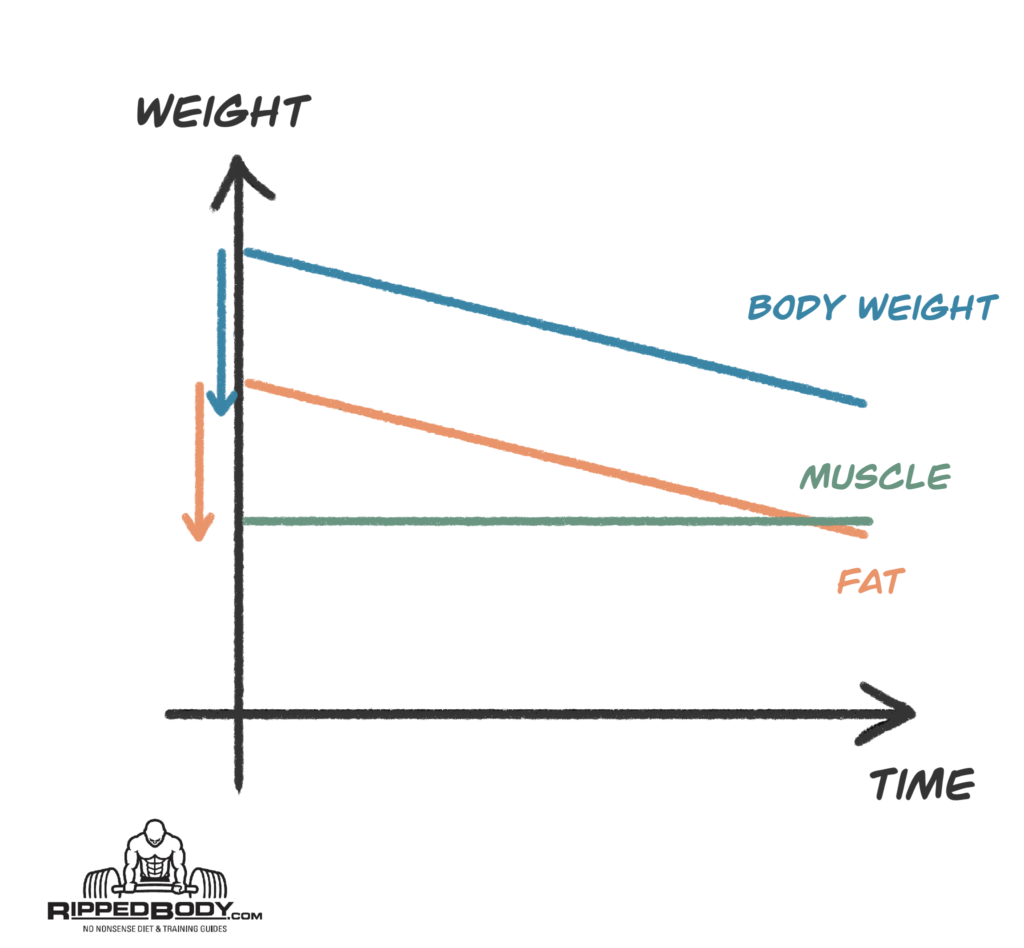
You may be able to gain some muscle during a cutting phase; however, your ability to do so decreases the leaner you get, the more advanced of a trainee you are, and the size of that calorie deficit. Any muscle gain achieved while cutting may not be obvious.
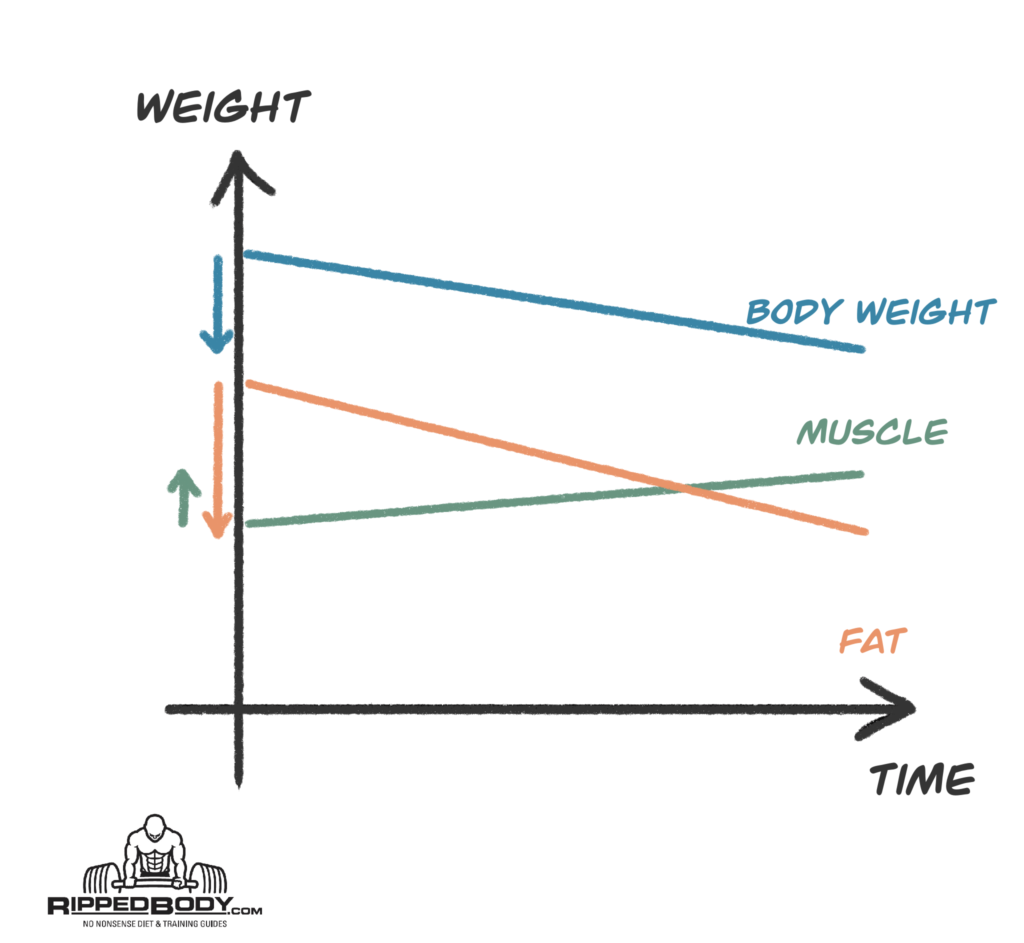
To put it another way, the fatter you are, and the less training experience you have, the more likely you are able to achieve a degree of both.Technically you could call this body recomposition, but as weight is still lost, I still like to call it a cut to make explanations easier.

»Choose to cut if you are overweight or carry a large amount of body fat, regardless of your level of training experience.
For those who are reading The Nutrition Setup Guide, Thicc Thelma and Fat Freddie will choose to cut.
You can use my macro calculator to calculate your calorie needs for a cut. For a more nuanced look at the weight loss recommendations, see my nutrition setup guide.
WHEN TO Bulk — A Muscle Gain Phase
The primary goal of a bulk is to gain muscle at a steady rate without gaining an unnecessary amount of fat. This is known asbulking.
I used the word "bulk" because that's probably what you Googled. But the term implies rapid weight gain likely to put on unnecessary body fat, leaving you frustrated and forcing you to cut your gaining phase short. Thus, I prefer the term "gaining".
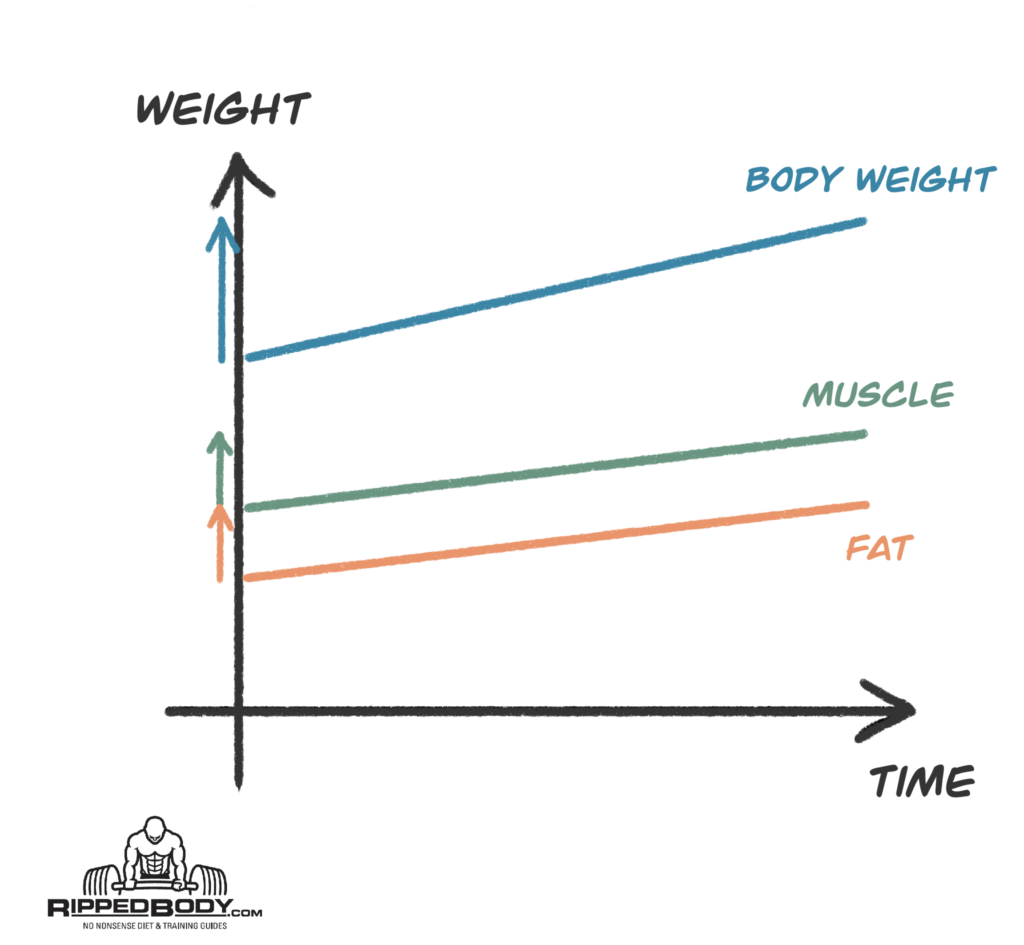
Gaining muscle requires the building of new tissue, so bulk phases take more time and require patience. Fortunately, the less advanced of a trainee you are, the faster your muscle growth rate.
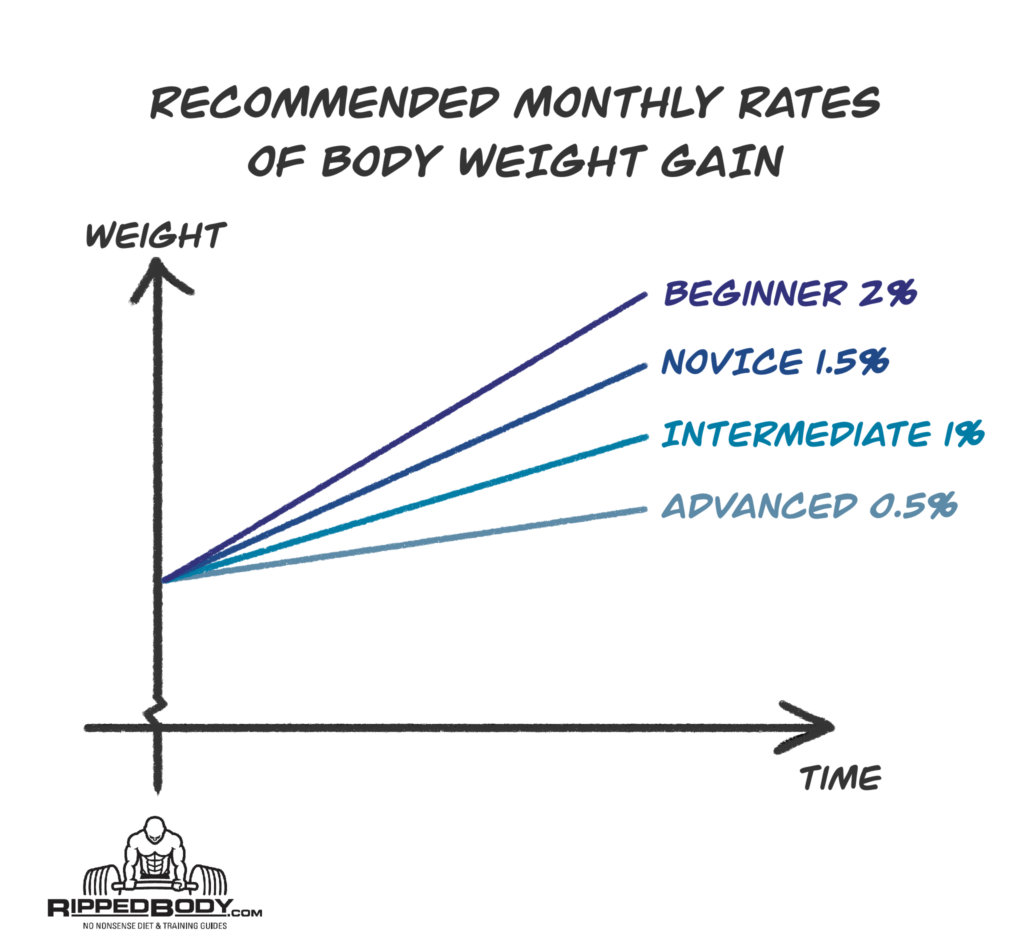
»Choose a bulk if you are underweight or are already lean enough to see your abs and wish to get bigger.
For those who are reading The Nutrition Setup Guide, Shredded Sam will choose to bulk.
You can use my macro calculator to calculate your calorie needs for a bulk. The nutrition setup guide covers recommended rates of appropriate weight gain based on your training level.
WHEN TO CHOOSE A BODY RECOMPOSITION GOAL
A body recomposition phase (often referred to as "body recomp") is generally typified by simultaneous muscle growth and fat loss, while weight remains stable.
Everybody wants simultaneous muscle growth and fat loss. However, the rate at which we can achieve this diminishes with training experience, so, I would only recommend this to relatively newer trainees and those coming back from a relatively long training layoff.

I do not recommend a body recomp to anyone who is underweight or overweight.
- If you are underweight, you should bulk.
- If you are overweight, you need to cut; however, the less training experience you have, the more likely it is that you will gain muscle at the same time as you lean out (though you'll lose weight overall).
The cutoff for the level of training experience where a recomp is unlikely to work is impossible to clearly define. If in doubt, consider giving it a shot for a couple of months. You can decide based on the outcome.
Further, you are welcome to try a body recomp at any point during your training career, but when progress is hard to measure, it is hard to manage and stay motivated, so I suggest most people build their physiques over time by alternating between fat loss and muscle gain phases.
»Choose a body recomp if you are relatively new to training or are coming back after a long layoff.
To hold your weight stable and do a body recomp you do not need to make any further adjustment to your calorie calculation after you have estimated your total daily energy expenditure.
For those who are reading The Nutrition Setup Guide, Noobie Natalie will shoot for a body recomposition goal.
Use my macro calculator to calculate your calorie needs for a body recomp.
ADVICE IF YOU CAN'T DECIDE WHETHER TO CUT OR BULK
If you are a novice trainee, and not really under or overweight (which is obviously a subjective judgment), consider the body recomp.
My definition of a novice trainee has nothing to do with the length of time you've been hitting the gym and everything to do with how effective your training has been. If you can still make consistent, linear progress in your training loads session to session, consider yourself a novice.
For everyone else, I have created the guidelines below, and that necessitates giving body-fat percentages. Unfortunately, all the means of estimating body fat have accuracy issues, so I recommend you assess your body-fat percentage using a mix of my visual guide to body-fat percentage and the US Navy method of estimating body-fat percentage.
Advice for non-novice trainees
» Cut–bulk phases are typically best kept in the 10–20% body fat range (add 8% for women).
» Bulking phases are best capped at 20% because past this point, the risk to health increases and I'd advise not bulking if you estimate yourself to be 16% body fat or above. — You want enough uninterrupted time to gain a meaningful amount of muscle before you need to cut. If this is you, get leaner first.
» You can cut to any point you wish, but lower than 10% body fat (for visual reference, the majority of the clients on the results page are all 8–10% body fat) doesn't really offer any advantage for a subsequent bulking phase. It may even be pointless to start a bulking phase at lower levels of body fat than this as the body is primed for fat regain. — The body doesn't want to be exceptionally lean, as it is a threat to survival.
» The majority of dedicated, physique-focussed clients find the sweet spot to be 10% body fat for the end of their cutting phases and 15% for the end of their bulk phases. You may find you prefer a higher range because you feel or perform better, but do not think you can do it effectively at a lower range. You will not make progress if you attempt to stay shredded lean all year round.
ADVICE FOR OBESE INDIVIDUALS
If you have obesity and are just starting a weight training program, I wouldn't necessarily advise you to purposely start tracking and weighing to achieve a targeted amount of energy restriction.
It's fine to adopt healthier eating habits (such as consuming more fruits, vegetables, protein, and water), but know that just becoming more active alone can give someone who was previously sedentary more finely tuned hunger signals, and body-fat percentage will go down even if muscle is gained without fat mass losses. Also, metabolic health will improve purely from resistance training without dieting.
Still, if you want some ideas on how to create a calorie deficit without counting, check out my guide: What to do before you start counting calories and macros.
Advice For 'SKINNY FAT' Individuals
Skinny fat means someone of "healthy" body weight, but who is muscularly under-developed.
Sometimes you might describe this person as 'skinny, with a potbelly.' But most often, the appearance is not that different from someone who is lean, but not muscled to the point where it's noticeable that they lift, yet.
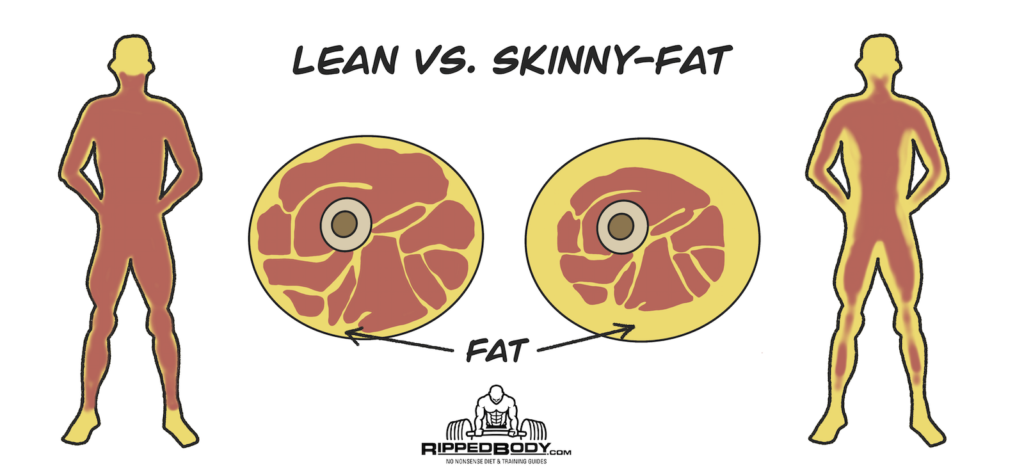
How do you know the difference?
Well, sometimes you don't know just by looking. But if you're weak and soft to the touch (despite tensing your muscles), you're skinny fat. This happens due to inactivity, and it's not uncommon for people to be lean down below and skinny-fat up top, depending on their hobbies (hikers, cyclists, runners, for example).
I'm not a fan of the term, but I hope it helps you understand what I'm referring to.
If this is you, I'd recommend that you shoot for a body recomp phase. (So, hold your calorie intake at maintenance level.) You're in a great position and should be able to make some excellent changes to your physique, strength, and feeling of wellbeing, over the course of the coming year.
If you're on the skinnier side of the skinny-fat spectrum, consider a slight calorie surplus, where you gain around 1% of your body weight per month.
If you're on the fatter side of the skinny-fat spectrum, consider cutting slowly. (A little slower than 0.5% of your body weight per week.)
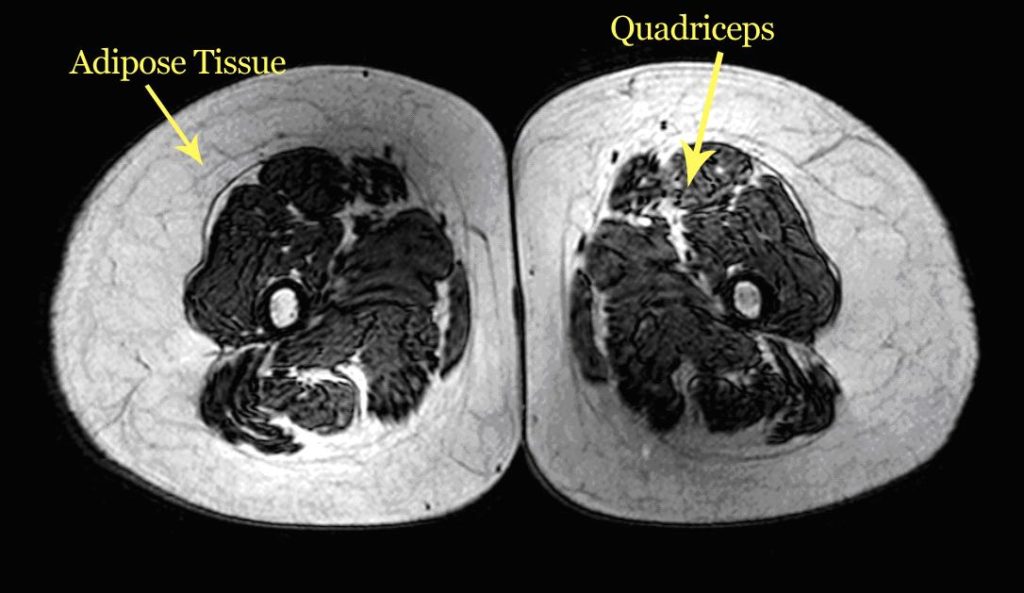
Just calculate for a body recomp, then adjust your calorie intake based on the outcome to do this. Here's the macro calculator. You'll see the instructions for adjusting there.
Advice For When To switch between Bulking and Cutting phases
Everybody reading this aspires to be jacked and lean. The way you will do that is by building and then carving your physique over back-to-back bulk and cut phases.
The drive for self-improvement is universal. Training becomes a habit for life. Even if you don't realize it now, this is the way it will be.
So the natural next question is then when we should switch from bulking to cutting, and vice-versa.
In short, I recommend we keep these phases in the ~10–18% body fat range. There are a few reasons for this, but first, take a look at the sketch below, showing what I mean by repeating back-to-back bulk and cut phases.

When To Stop Cutting And Start Bulking
It's best to avoid getting ridiculously shredded lean if the goal is to just switch to a bulking phase. You'll be so hungry that you'll gain weight too quickly, and you'll be more primed for fat storage.
Stop when you get to the point where you are feeling exceptionally food-deprived and hungry. This often around 8–10% for men and 16–18% for women.
I recommend you give yourself a minimum of 5 months for each bulk phase so that you don't interrupt the anabolic process. You need to be lean enough when you start bulking that you aren't unhappy with your body shortly after starting it.
It was previously thought that if we aren't reasonably lean when starting to bulk, we'll gain a disproportionate amount of fat and little in the way of muscle. This concept is called your 'P-ratio,' which is simply defined as the proportion of fat to muscle you put on when gaining weight.
Indeed, there is research showing that very lean people—who are naturally lean, not who dieted—gain more lean body mass during periods of overfeeding, and people with obesity gain more body fat during periods of overfeeding.
However, two things that are frequently misunderstood are: 1) putting on more lean body mass when overfeeding occurs innaturallylean people who walk around lean. If you dieted to get really lean, your body if anything, is actually a bit more primed for fat storage. Also; 2) that this relationship is based on observations of individuals who aren't resistance training.
If you start lifting weights this drastically changes the game. Nutrient partitioning in your now highly active skeletal muscle is much more favorable for muscle gain as you are providing a stimulus for growth and regularly depleting your muscle of energy and pushing them to become energy efficient and adapt.
If it was true that individuals with a high body fat couldn't gain muscle mass effectively, sumo wrestlers wouldn't have the highest recorded lean body masses of any athlete…but they do. Likewise, super heavyweight powerlifters would be weaker than weight classes below them, but they aren't.
When To Stop Bulking And Start Cutting
There probably should be some limit to how high your body fat is before you decide it would be better to cut versus bulk, but it's for logistical reasons, not "anabolic resistance".
I would recommend that don't go beyond 20% body fat, as past this point, and there are increased health risks. Many people will want to stop sooner than this, but I'd advise you do not make the mistake of trying to stay lean all the time because this will limit your ability to grow. This is why I recommend a 5-month minimum.
SUMMARY GUIDELINES ON HOW TO CHOOSE TO CUT, BULK, OR RECOMP
| CATEGORY OF TRAINEE | RECOMMENDATION |
|---|---|
| Overweight | Cut |
| Underweight | Bulk |
| Inexperienced trainee in the 13–18% body-fat range | Recomp |
| Experienced trainee over 16% body fat | Cut |
| Experienced trainee under 16% body fat | Cut or bulk, as per preference |
| When bulking, suggested upper body fat limit to switch to a cut | 20% |
| When cutting, suggested lower body fat limit to switch to a bulk | 9–10% |
Bulk vs Cut (or Recomp) FAQ
Should you bulk or cut first?
If you are underweight, youshould bulk. If you are overweight, you need tocut; however, the less training experience you have, the more likely it is that youwill gain muscle simultaneously as you lean out (though you'll lose weight overall). I've explained the distinctions so you know what you can expect to achieve in this guide.
Can you cut and bulk at the same time?
Cutting means to lose weight with a focus on fat loss. Bulking meals to gain weight with a focus on muscle growth. So, it is not possible to cut and bulk simultaneously, but it is possible to gain muscle and lose fat at the same time under certain circumstances, which I explain in this guide.
Is cutting better than bulking?
If you currently have a lot of fat to lose, cutting is better than bulking, because it will improve your physique and improve your health. Also, as fat loss can happen faster than muscle can be gained, cutting is easier to stay motivated for. For some people, it can be tricky to choose between cutting or bulking first. This is where this guide comes in.
How long should you bulk before you cut?
I recommend that people bulk for a minimum of five months before cutting so that the muscle-building process isn't interrupted before a measurable amount of progress is made. There is no maximum time frame, but I recommend people don't exceed 20% body fat for health reasons. Most physique-focussed trainees will choose to stop bulking before this.
Final Words
Lastly, regardless of what I say here if you feel strongly pulled towards doing something different, do it. Don't let some guy on the internet tell you that you're too fat to bulk or too skinny to cut if that's what you really want to do. These are guidelines, not rules.
Thank you for reading. If you found this useful, you're sure to get a lot out of my Nutrition Setup Guide also. Download it by entering your email address in the box below.
Source: https://rippedbody.com/cut-or-bulk/
0 Response to "Can I Cut for a Week Then Bulk Again"
Post a Comment